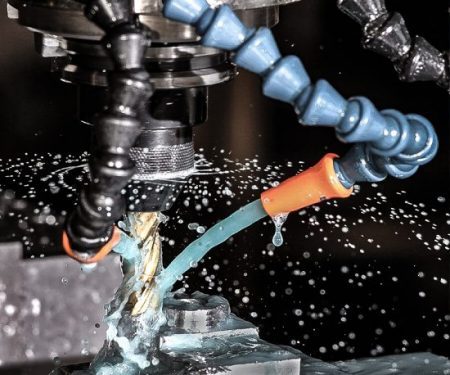For your metalworking operation, you have a variety of options in selecting a coolant to use. The first decision is selecting which classification of metalworking lubricant to use. The four main classifications are:
When selecting which fluid classification, it is important to consider: cooling, lubrication, chip removal, and corrosion protection. Each classification has its strengths and weaknesses, which should be considered when evaluating coolant needs. For certain processes, a neat oil may be better than a semi-synthetic and vice versa.
Let’s examine synthetic coolants. These contain zero mineral oil content, hence synthetic coolant. When diluted, the fluid appears transparent and is a true solution with no droplet formation. One of the main benefits of synthetic coolants is zero foaming. Foaming generally appears in fluids with higher mineral oil content. If your synthetic fluid begins to foam, it is a clear sign that the coolant is contaminated.
The chemical composition of synthetic coolants makes for a robust product and more durable solution. Synthetics are much more stable than other classifications of metalworking fluids. The robust chemistry can create solutions that can reject all tramp oils. With less tramp oils in the sump, this creates a higher performing product and less likely to become contaminated.
This allows for a longer-lasting solution and higher efficiency in recycling the fluid. To offset the higher costs of synthetic coolants, fluid consumption is reduced because the fluid is a true solution. Less concentrate is needed to recharge the solution; therefore, it will take longer to use entire container.
Metalworking fluid selection is based on finding the balance between cooling and lubrication. Synthetic lubricants are preferred in operations where cooling is important in a metalworking fluid. They are formulated for rapid heat dissipation. If your process generates a lot of heat, synthetics may be preferable to ensure temperature control and high performance.
The fluid will last longer, however that is only if you are using best practices in fluid management. Synthetics are designed for specific concentrations and are less forgiving than other classifications of metalworking fluids. Tighter concentration control is needed for synthetics and you have to monitor the solution daily. Even though fluid management is more rigorous, it is easier to control and measure concentration because it is a transparent and droplet-free solution.
Whether you are facing foaming problems, high temperature operations or shorter coolant lifespans, the decision to switch to a synthetic coolant may be one to consider. Even though synthetic coolants are generally more expensive than other coolant classifications, the benefits will reveal themselves as you use the synthetic coolant. A synthetic coolant will last longer than a soluble oil and is much easier to reclaim and recycle. The performance of synthetic coolants is superior than semi-synthetics and will cool the work-piece and tool more effectively. Superior chemical formulation will protect your sump from tramp oils and other outside contamination. This protection along with zero-foam will keep your operation running longer with reduced downtime. Your coolant concentrate will last longer and can create significant cost savings over time.

